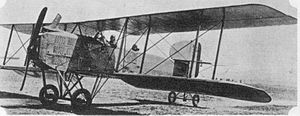9th Aero Squadron
| 9th Aero Squadron | |
|---|---|

French Breguet 14 B.2 bomber, the type used by the 9th Aero Squadron
|
|
| Active | 14 June 1917-22 July 1919 |
| Country |
|
| Branch |
|
| Type | Squadron |
| Role | Night Observation |
| Part of | American Expeditionary Forces (AEF) |
| Nickname(s) | "Bats" |
| Engagements |
World War I Occupation of the Rhineland |
| Commanders | |
| Notable commanders |
Capt. George E. A. Reinburg Lt Samuel B. Eckert |
| Insignia | |
| 9th Aero Squadron Emblem |  |
| Aircraft flown | |
| Bomber | Breguet 14, 1918-1919, Royal Aircraft Factory F.E.2, 1918-1919 |
| Fighter |
Sopwith Camel, 1917 Sopwith Scout, 1917 |
| Trainer | Curtiss JN-4, 1917 |
| Service record | |
|---|---|
| Operations |
First Army Observation Group
|
First Army Observation Group
Western Front, France: 26 August-11 November 1918
The 9th Aero Squadron was a Air Service, United States Army unit that fought on the Western Front during World War I.
The squadron was assigned as an Army Observation Squadron, performing long-range, strategic night reconnaissance over the entire length of the United States First Army sector of the Western Front in France. It was the only night reconnaissance squadron of the Air Service stationed on the Western Front, and the squadron's emblem reflects an aircraft, flying at night with searchlights searching for it in a IX pattern.
After the 1918 Armistice with Germany, the squadron was assigned to the United States Third Army as part of the Occupation of the Rhineland in Germany. It returned to the United States in June 1919 and became part of the permanent United States Army Air Service in 1921, being re-designated as the 9th Squadron (Observation) .
The current United States Air Force unit which holds its lineage and history is the 9th Bomb Squadron, assigned to the 7th Operations Group, Dyess Air Force Base, Texas.
The 9th Bomb Squadron origins begin on 30 May 1917, when Company E, Provisional Aviation School Squadron at Kelly Field, San Antonio Texas was designated as a separate unit. The men, who had been in training for about a month, were officially designated as the 9th Aero Squadron on 14 June. On 5 July, the squadron was ordered to a new airfield at Mt. Clemens, Michigan, where, with the 8th Aero Squadron, opened what became known as Selfridge Field. At Selfridge, the men of the 9th assembled a Curtiss JN-4 Jenny, the first airplane to ever fly there. The airfield was still mostly pasture land, and construction of accommodations were underway for 150 aircraft at the field. The airfield was gearing up to train men in flying, bombing, radio and photography for the war effort. During the summer of 1917, 72 men won aviator ratings and logged over 3,700 flying hours.
...
Wikipedia
